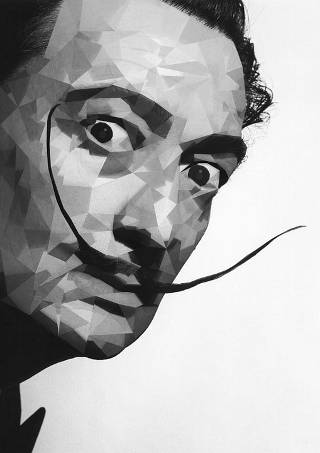Thank Math for Your Favorite Artist
Your favorite artist probably has a mathematician to thank for inspiration.

Photo courtesy of Pixabay
Artists and architects have blended mathematical elements into their works since before the fourth century B.C. Such ancient grand structures as the Parthenon on the Acropolis in Athens wouldn't still be standing had artists not understood principles of geometry, algebra, perspective and proportion. In more modern times, Dutch-born M.C. Escher was a civil engineer's son who worked to incorporate math into works ranging from books to tapestry and murals.
But one of the best examples of how math is interwoven into art shows up in the works of 20th century painter Salvador Dali, and the Renaissance master, Leonardo da Vinci. A STEAM (science, technology, arts and mathematics) innovator and Renaissance man, da Vinci pointed to math as a foundation to his art, even saying that people who hadn’t studied math really would never understand his work.
From perspective drawing to studying geometry under Luca Pacioli in Italy, mathematics and the classical ideal of the Golden Ratio is omnipresent in his work.
Salvador Dali was a great admirer of Leonardo da Vinci, especially in the rhombicuboctahedron work (a polyhedron with 18 square and 8 triangular sides) he did under Pacioli. Dali took polyhedra to the next level in his The Sacrament of the Last Supper, in which Christ and his disciples are pictured inside a giant dodecahedron (a polyhedron with 12 flat sides) and Crucifixion (Corpus Hypercubus), a painting of a 3D polyhedron net of a 4D analog cube.
"Those who fall in love with practice without science are like a sailor who enters a ship without a helm or a compass, and who never can be certain whither he is going," he said. "Practice must always be founded on sound theory, and to this, perspective is the guide and the gateway; and without this nothing can be done well in the matter of drawing." Leonardo da Vinci, 1452-1519
Exhibitions across the world have compared da Vinci and Dali. Dali Museum Executive Director, Dr. Hank Hine, said, of an exhibition comparing da Vinci and Dali, "Four centuries following the Renaissance, which Leonardo exemplified, Salvador Dali developed his own relationship with science and math, and he looked to da Vinci for inspiration."
But the most powerful connection between the two was the one that Dali drew himself.
Dali read an article published by Sigmund Freud in the late 1920s called, "Leonardo da Vinci and a Memory of His Childhood," analyzing Leonardo's paintings in detail. For example, in da Vinci's Madonna and Child with St. Anne, the artist used literal and figurative double imagery, common to geometry. Leonardo's influence casts a long shadow on Dali's works.
What can the modern art aficionado, scientist or budding tech startup (e.g. a STEAM lover) take from this interplay across the centuries?
It's no secret that STEM and STEAM jobs are set for major growth in the U.S. in the coming decade. In fact, the U.S. Department of Education estimates that STEM jobs will grow twice as fast (increasing by as much as 14 percent) by 2020 compared to the average growth rate of other jobs.
However, like many of those jobs that are math- and science-based, from data science to engineering and programming, these may be jobs where humanities, visual and fine arts are crucial for success, from engineering and architecture to UI design, front-end web programming, marketing and advertising.
We may all take a page from da Vinci and Dali in appreciating this. Like the two sides of a coin, STEM and creativity work best when they work together.
Just do the math!
Want to Learn More?
- Permanent Collection Archives. "Unparalleled collection of Salvador Dali art works." , 30 Nov, -0001. http://archive.thedali.org/mwebcgi/mweb.exe?request=collection. Accessed on 16 May, 2017.
- "The Concept Of Space In Twentieth Century Art." , 30 Nov, -0001. http://legacy.ski.org/CWTyler_lab/CWTyler/Art%20Investigations/C20th_Space/C20thSpace.html. Accessed on 16 May, 2017.
- Fanés, Fèlix. "Salvador Dalí: the construction of the image." New Haven: Yale U Press, 1 Jan, 2007. . Accessed on 16 May, 2017.
- Gamwell, Lynn, and Neil Degrasse Tyson. "Mathematics and Art - A Cultural History." New Jersey: Princeton U Press, 1 Jan, 2015. . Accessed on 16 May, 2017.
- Illusions Through the Paintings of Salvador Dali.. "Chill Out Point - Funny image galleries and artwork." , 30 Nov, -0001. http://www.chilloutpoint.com/art_and_design/illusions-through-the-paintings-of-salvador-dali.html. Accessed on 16 May, 2017.
- U.S. Department of Education. "Science, Technology, Engineering and Math: Education for Global Leadership." , 30 Nov, -0001. . Accessed on 16 May, 2017.
- Permanent Collection Archives. "Unparalleled collection of Salvador Dali art works." , 30 Nov, -0001. http://archive.thedali.org/mwebcgi/mweb.exe?request=collection. Accessed on 16 May, 2017.
- "The Concept Of Space In Twentieth Century Art." , 30 Nov, -0001. http://legacy.ski.org/CWTyler_lab/CWTyler/Art%20Investigations/C20th_Space/C20thSpace.html. Accessed on 16 May, 2017.
- Fanés, Fèlix. "Salvador Dalí: the construction of the image." New Haven: Yale U Press, 1 Jan, 2007. . Accessed on 16 May, 2017.
- Gamwell, Lynn, and Neil Degrasse Tyson. "Mathematics and Art - A Cultural History." New Jersey: Princeton U Press, 1 Jan, 2015. . Accessed on 16 May, 2017.
- Illusions Through the Paintings of Salvador Dali.. "Chill Out Point - Funny image galleries and artwork." , 30 Nov, -0001. http://www.chilloutpoint.com/art_and_design/illusions-through-the-paintings-of-salvador-dali.html. Accessed on 16 May, 2017.
- U.S. Department of Education. "Science, Technology, Engineering and Math: Education for Global Leadership." , 30 Nov, -0001. . Accessed on 16 May, 2017.